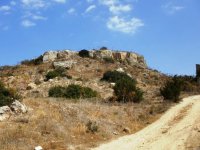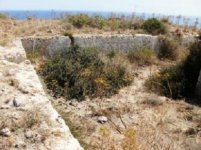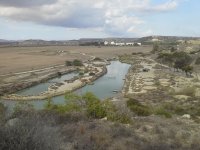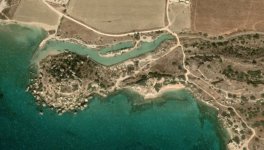Crow
Silver Member
- Jan 28, 2005
- 3,852
- 10,691
- Detector(s) used
- ONES THAT GO BEEP! :-)
- Primary Interest:
- Other
Gidday Amigo
If one was inclined to search for Templar treasure for a site that might hold a small cache of Templar coins?

Gastria castle was located on the Northern shore of the Bay of Larnaca, 3 km 1.9 miles southwest of the village of Gastria. In 1191 Cyprus was seized by Richard the Lionheart during his campaign against the ruler of the island Isaac Comnenus of Cyprus.

Then Richard sold the island to the knights Templar, whose reign ended abruptly after a major riot in Nicosia. Then Cyprus was given to guy de Lusignan. the house of Lusignan. Gastria castle is first mentioned in 1210, when king Regent Walter of Montbeliard took refuge in the fortress with his allies the Templars. Previously, he has refused to report on his administration of the Royal Treasury to the newly born Hugh I of Cyprus, then flee to the Kingdom of Jerusalem. The period of peace ended with the death of Hugh in 1218. Here is Hugh I Cyprus picture below.

The struggle over who should act as Regent of the Kingdom followed, pitting the house of Ibelin with local supporters of Frederick II, Emperor of the Holy Roman Empire. Fredericks arrival in Paphos in 1228 escalated the conflict into open war. In 1229, John of Ibelin, the old Lord of Beirut, returned to Cyprus via Gastrias port.
Ruins of ancient port might be worth searching also for coins?
In 1232 after the defeat at the battle of Agridi, Fredericks few remaining supporters, asking for permission to hide in Gastria. Having fought Frederick in acre in 1229, the knights Templar refused, and those who tried to hide in a ditch and was arrested.
Then Lusignan, the continuation of their rule, interrupted only rare of Palace coups. In 1279, Hugh III of Cyprus dismantled the castle and expelled the Templars, after the latter announced his support of Charles I in Naples.
In 1308 the castle was granted to the knights Hospitaller. In 1310, Henry II of Jerusalem passed through the Gastria on the way into exile in Armenia. He was no longer mentioned as a castle from this point.

Gastria was a small rectangular Fort located at the end of a long narrow ridge. He was separated from the ridge into a rocky ditch 7.9–4.5 meters 26-15 feet wide and 2-2.6 meters 6.6–8.5 ft deep. The ditch passed the bridge or wooden bridge.
However, with the characteristics of small fortresses of the knights Templar, Gastria had no towers. In the center of the Fort were placed round the tank. In the East a natural shelter in the form of a cliff overlooking the sea and the Fort bears the signs that it was once busy. To the North of the Fort, and the exposure of the isthmus, is a watercourse that served as a harbour.

Gastria is unkempt and uncared for. There are only a few remains of the walls and what looks like a dry moat that separates the motte from the bailey.
Such an interesting abandoned and forgotten place in history that once was a Templar fortress may yield small caches of coins?
Crow
If one was inclined to search for Templar treasure for a site that might hold a small cache of Templar coins?

Gastria castle was located on the Northern shore of the Bay of Larnaca, 3 km 1.9 miles southwest of the village of Gastria. In 1191 Cyprus was seized by Richard the Lionheart during his campaign against the ruler of the island Isaac Comnenus of Cyprus.

Then Richard sold the island to the knights Templar, whose reign ended abruptly after a major riot in Nicosia. Then Cyprus was given to guy de Lusignan. the house of Lusignan. Gastria castle is first mentioned in 1210, when king Regent Walter of Montbeliard took refuge in the fortress with his allies the Templars. Previously, he has refused to report on his administration of the Royal Treasury to the newly born Hugh I of Cyprus, then flee to the Kingdom of Jerusalem. The period of peace ended with the death of Hugh in 1218. Here is Hugh I Cyprus picture below.

The struggle over who should act as Regent of the Kingdom followed, pitting the house of Ibelin with local supporters of Frederick II, Emperor of the Holy Roman Empire. Fredericks arrival in Paphos in 1228 escalated the conflict into open war. In 1229, John of Ibelin, the old Lord of Beirut, returned to Cyprus via Gastrias port.
Ruins of ancient port might be worth searching also for coins?
In 1232 after the defeat at the battle of Agridi, Fredericks few remaining supporters, asking for permission to hide in Gastria. Having fought Frederick in acre in 1229, the knights Templar refused, and those who tried to hide in a ditch and was arrested.
Then Lusignan, the continuation of their rule, interrupted only rare of Palace coups. In 1279, Hugh III of Cyprus dismantled the castle and expelled the Templars, after the latter announced his support of Charles I in Naples.
In 1308 the castle was granted to the knights Hospitaller. In 1310, Henry II of Jerusalem passed through the Gastria on the way into exile in Armenia. He was no longer mentioned as a castle from this point.

Gastria was a small rectangular Fort located at the end of a long narrow ridge. He was separated from the ridge into a rocky ditch 7.9–4.5 meters 26-15 feet wide and 2-2.6 meters 6.6–8.5 ft deep. The ditch passed the bridge or wooden bridge.
However, with the characteristics of small fortresses of the knights Templar, Gastria had no towers. In the center of the Fort were placed round the tank. In the East a natural shelter in the form of a cliff overlooking the sea and the Fort bears the signs that it was once busy. To the North of the Fort, and the exposure of the isthmus, is a watercourse that served as a harbour.

Gastria is unkempt and uncared for. There are only a few remains of the walls and what looks like a dry moat that separates the motte from the bailey.
Such an interesting abandoned and forgotten place in history that once was a Templar fortress may yield small caches of coins?
Crow




 Crow
Crow
 Do you think that this site is still worth a visit? I see it's been 4 years.
Do you think that this site is still worth a visit? I see it's been 4 years.

